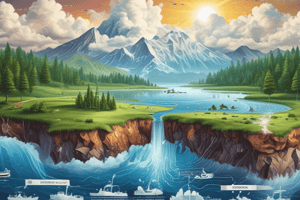Podcast
Questions and Answers
The ______ cycle is the continuous recycling of water on earth;
The ______ cycle is the continuous recycling of water on earth;
water
Water has three ______ or forms;
Water has three ______ or forms;
states
The process of the earth recycling water is called the ______ cycle;
The process of the earth recycling water is called the ______ cycle;
water
One of the forms of water is ______ such as ice;
One of the forms of water is ______ such as ice;
The force of ______ pulls the water droplets back down to the earth;
The force of ______ pulls the water droplets back down to the earth;
The energy of the ______ transforms surface water into water vapor;
The energy of the ______ transforms surface water into water vapor;
Evaporation occurs when the ______ heats up water.
Evaporation occurs when the ______ heats up water.
Water vapor rises up into the ______.
Water vapor rises up into the ______.
During condensation, water changes from gas to ______.
During condensation, water changes from gas to ______.
Clouds are made up of million tiny droplets of ______.
Clouds are made up of million tiny droplets of ______.
When the atmosphere is cold enough, precipitation can change from rain to ______.
When the atmosphere is cold enough, precipitation can change from rain to ______.
In the last stage of the water cycle, water can be soaked up by the ______.
In the last stage of the water cycle, water can be soaked up by the ______.
Flashcards are hidden until you start studying
Study Notes
The Water Cycle
- The water cycle is the continuous recycling of water on earth, from the oceans to the sky and back to land, and then transported back to the oceans and sky again.
- The water cycle is driven by the energy of the sun, which transforms surface water into water vapor.
The Three States of Water
- Solid: ice
- Liquid: wet and fluid
- Gas: water vapor in the air
The Four Processes of the Water Cycle
- Transpiration/Evaporation: the sun heats up water in seas, rivers, lakes, oceans, and glaciers, turning it into water vapor or steam, which rises into the atmosphere; plants and soil also release water vapor through transpiration.
- Condensation: water vapor cools and condenses, changing from gas to liquid (water droplets), forming clouds.
- Precipitation: when clouds become too heavy with water, the water falls back to the earth; if the atmosphere is cold enough, precipitation can take the form of snow or sleet.
- Collection/Water Storage: water returns to bodies of water, such as oceans, seas, rivers, lakes, and glaciers, or is absorbed into the soil through infiltration.
Studying That Suits You
Use AI to generate personalized quizzes and flashcards to suit your learning preferences.




